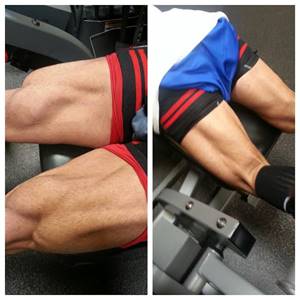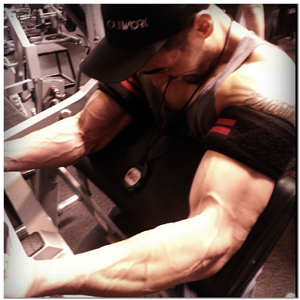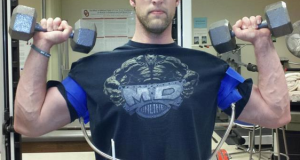Train Loco readers, boy do we have a special treat for you all today! We have an awesome interview with the “Blood Flow Restriction Godfather,” Jeremy Loenneke. We have known Jeremy for a couple of years now and have followed his work extensively on blood flow restriction. He is a true professional in the field, a machine with writing manuscripts and researching, and he’s also a fellow team Norton member 🙂 Without further ado, let us introduce to you the “Blood Flow Restriction Godfather.”
Enjoy!
-Eric and Chris
DDT: Could you give us a little background info on who Jeremy Loenneke is?
J: I grew up in SE Missouri where I attended Southeast Missouri State University. I did my undergraduate/masters there where I worked closely with Dr. Joe Pujol and Dr. Jeremy Barnes. From there I went to the University of Oklahoma, where I work with Dr. Mike Bemben. I recently defended my dissertation and I’m staying busy trying to find a job/post-doctoral position.
DDT: What got you started or inspired to get into the (Health, Fit, Athletic, Bodybuilding) Lifestyle?
J: I wrestled from first grade all the way through high school. Although I enjoyed the sport I never really did put a lot of effort into training outside of the wrestling room. Following my junior year, it became clear to me that I needed to start taking it seriously otherwise I wouldn’t be very competitive my senior year. The spring of my junior year and the summer that followed was filled with training and eating. My buddy was always working out and reading the bodybuilding magazines, so I started training with him and reading as much as I could. I focused all of my time and energy into getting stronger and when I came back to school for my senior season I was noticeably larger. I went from wrestling 152 to 215 (no it wasn’t all muscle). During my senior season, I came across this guy online who was posting a lot of information (you may have heard of him…his name was Layne Norton). Following his information and others, I slowly worked my way into the sport of bodybuilding and then powerlifting as well.
DDT: You just recently defended your dissertation and became Dr. Jeremy Loenneke, take us through the feelings of your journey?
J: Words can’t even describe the journey but I’ll give it my best shot. In high school and all through college I worked at an Ice Plant (for various reasons). It was hard work and it made me realize that I didn’t want to do that type of work my whole life. Believe it or not, I didn’t take school seriously at all in high school or my first couple of years of college. It was a whole lot of showing up and doing things at the last second. Following my second year of undergrad, I got some inspiration from one of my professors (even though he probably didn’t know it). Essentially he had found out that I was enrolled to take this really tough class from this really tough professor. He told me that I would probably get a “C” in the class but that I would learn more than if I took it with this other professor who tended to be easier. It was then that I realized I had coasted through school long enough. It became clear to me that people saw me as a middle of the road type of person…essentially people didn’t think I was very smart or take me seriously (couldn’t really blame them). From that moment on I started taking it seriously and started to read and read and read and read. I ended up graduating with honors from my undergrad and masters and made my way to Oklahoma…the rest is history. I went through a lot to get to where I am and I paid the price every single day and my conclusion is this…it was all worth it.
DDT: You’re known as the “BFR (Blood Flow Restriction) God Father.” Can you give us a brief overview of What BFR consists of?
J: BFR is a technique where a wrapping device is applied to the limb with the goal of restricting blood flow into the muscle and completely occluding blood flow out of the muscle. This technique allows a person to train with low loads but still observe muscular benefits similar to that of higher load training.
DDT: What fascinated you to do your PhD work in the direct study of BFR?
J: The idea that a person could restrict blood flow to a muscle and make it respond in a favorable way literally blew my mind. In addition, several questions remain unanswered with BFR which keeps me interested in the topic.
DDT: A lot of our readers range from beginners, novice, and to advanced athletes, how can BFR be applied to these 3 types of trainees?
J: It really depends on several different factors. I am assuming with my response that all three are able-bodied and capable of lifting weights. The main thing that separates beginners from novices from athletes is the overall training load/frequency. For example, those who are beginners don’t need to be training 3-4x a week because they are deconditioned enough to see benefits with a frequency of 1-2x a week. In contrast, those who are novice may reach a point where they need to bump volume and/or frequency up to 2-3x a week (so on and so forth). One thing that is interesting about BFR is that the mechanisms behind the strength gain appear almost entirely due to rapid muscle hypertrophy. This is in contrast to the strength gain observed with traditional high load training which is due to neural changes initially and then muscle hypertrophy. Thus, it stands to reason that one may optimize training by including both types of training.
DDT: What are some BFR protocols beginner, novice, and advanced athletes can perform?
J: Please keep in mind that these are just general recommendations…this is not to say that this is the best way…but it is one way (of many) to use BFR in conjunction with regular training. If you choose to train without BFR, you will still see increases in muscle size and strength provided your program follows the principle of progressive overload. However, using BFR may be beneficial in that the time required to recover from BFR exercise is a lot less than the time required for traditional higher load training. I would complete BFR exercise at around 30% of your maximal load and make sure the exercises are completed under control (tempo of 1 second up/1 second down).
__________________________________________________________________________
Beginner [2 days per week/hitting each body part 2x per week]
Day 1 (All Traditional)
Squat
Bench Press
Shoulder Press
Rows
Bicep Curls
Narrow Bench
Day 2 (All under Blood Flow Restriction)
Knee Extension (30, 3 sets of 15….30s rest)
Leg Curl (30, 3 sets of 15…30 s rest)
Calves (3 x15…30 s rest)
(I’d start wrapping it for the first exercise and then unwrapping it for 5 minutes before reapplying it for the next exercise….over time you can work towards leaving them on for all continuously).
Bench Press (4 x 15-20….30 s rest)
Shoulder Press (3 x 15…30 s rest)
Row (4 x 15-20…30 s rest)
Bicep curl (3 x 15…30
(I’d start wrapping it for the first or second exercise and then unwrapping it for 5 minutes before reapplying it for the next 2-3 exercises….over time you can work towards leaving them on for all continuously).
__________________________________________________________________________________
Novice [3 days per week/hitting each body part 3x per week]
Day 1 (All Traditional)
Squat
Bench Press
Shoulder Press
Rows
Biceps Curl
Narrow Bench
Day 2 (All under Blood Flow Restriction)
Knee Extension (30, 3 sets of 15….30s rest)
Leg Curl (30, 3 sets of 15…30 s rest)
Calves (3 x15…30 s rest)
(I’d start wrapping it for the first exercise and then unwrapping it for 5 minutes before reapplying it for the next exercise….over time you can work towards leaving them on for all continuously).
Bench Press (4 x 15-20….30 s rest)
Shoulder Press (3 x 15…30 s rest)
Row (4 x 15-20…30 s rest)
Bicep curl (3 x 15…30
(I’d start wrapping it for the first or second exercise and then unwrapping it for 5 minutes before reapplying it for the next 2-3 exercises….over time you can work towards leaving them on for all continuously).
Day 3 (All Traditional)
Squat
Deadlift
Bench Press
Shoulder Press
Pullups
Tricep Extensions
Bicep Curls
________________________________________________________________________________
Advanced [4 days per week/hitting each body part 4x per week]
Day 1 (Upper Traditional/Lower BFR)
Bench Press
Shoulder Press
BB Rows
Narrow Bench
Squat (4 sets of 12-15…30 s rest)
Leg Extensions (30, 3 sets of 15…30 s rest)
Leg Curl (20, 2 sets of 15…30 s rest)
Calves (20, sets of 15…30 s rest)
(I’d take the wraps off following the squat and then reapply for the next exercise. I would work to try and complete leg extensions, leg curls, and calves without unwrapping. It will obviously take time for you to work to this)
Day 2 (Lower Traditional/Upper BFR)
Deadlift
Squat
Leg Extensions
Calves
Bench Press (4 sets of 12-15…30 s rest)
Shoulder Press (20, 2 sets of 15…30 s rest)
BB Rows (30, 3 sets of 15…30 s rest)
Narrow Bench (20, 2 x 15…30 s rest)
Bicep Curls (20, 2 x 15…30 s rest)
(I’d take the wraps off following the shoulder press and then reapply for the next exercise. I would work to try and complete BB Rows, Narrow Bench, and Bicep Curls without unwrapping. It will obviously take time for you to work to this)
Day 1 and Day 2 could be done on Monday/Tuesday and then repeated on Thursday/Friday.
________________________________________________________________________________
DDT: Where do you see BFR training in the next 5-10 years?
J: I think its use will continue to expand into the clinical realm, especially here in the USA. I also think a lot of mechanistic work will be completed to further our understanding of just how BFR is working. In addition, I wouldn’t be surprised if more able-bodied lifters start implementing BFR training into their regular training to boost frequency/volume without increasing their recovery time.
Fun Time!
DDT: If you had to choose one style of training…Powerlifting or Bodybuilding…What would it be and why? (and no you can’t pick both J)
J: I have trained and competed in both bodybuilding and powerlifting. Although I enjoyed both, I would choose bodybuilding because there isn’t anything better than feeling a pump (just ask Arnold) and being as big and lean as possible. Outside of my PhD, nothing has felt quite as satisfying as training and dieting for a bodybuilding show.
DDT: What is your favorite lift and why?
J: I think the squat is one of the best lifts that you can do for yourself. With that being said, the deadlift is hands down my favorite lift. Nothing feels quite as good as picking up something heavy and setting it back down. Curls will also always have a special place in my heart. Let’s be honest, every bodybuilder will always have some “bro” love for the feeling in your arms after curling. If you disagree with the curling comments, you are lying to yourself.
DDT: What does Jeremy like to do for fun? Don’t be shy now 😉
J: Outside of research and reading manuscripts (which I view as fun)….I enjoy lifting weights, eating food, watching sports (especially college football….BOOMER SOONER), seeing a good movie, and more than all of that I just love hanging out with my friends. In my spare time I also enjoy making sure that people don’t misrepresent science to the masses (mostly on twitter), particularly in the field of nutrition and exercise.
DDT: Where can our readers and supporters follow you and find more of your work on Blood Flow Restriction?
J: The best place to get info from me is Twitter @jploenneke
For access to a lot of our work, type in pubmed.com and search Loenneke JP
DDT: Thanks for taking the time to let us interview you Jeremy.
J: Thanks Champions and remember…you can’t out diet a bad training program.
Here Are Some Videos on BFR Training:




